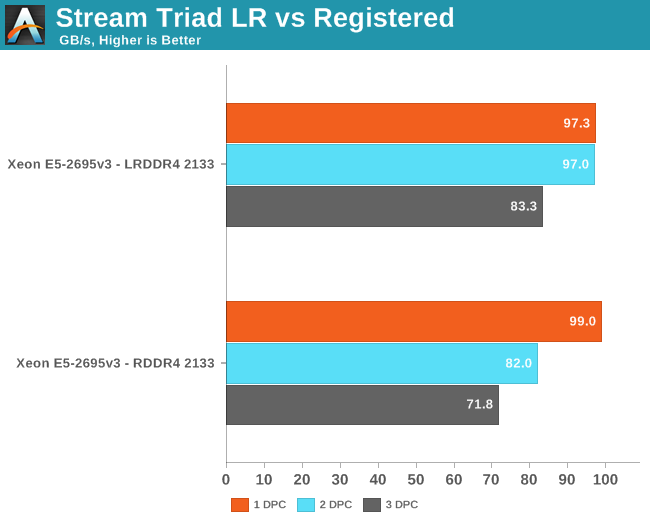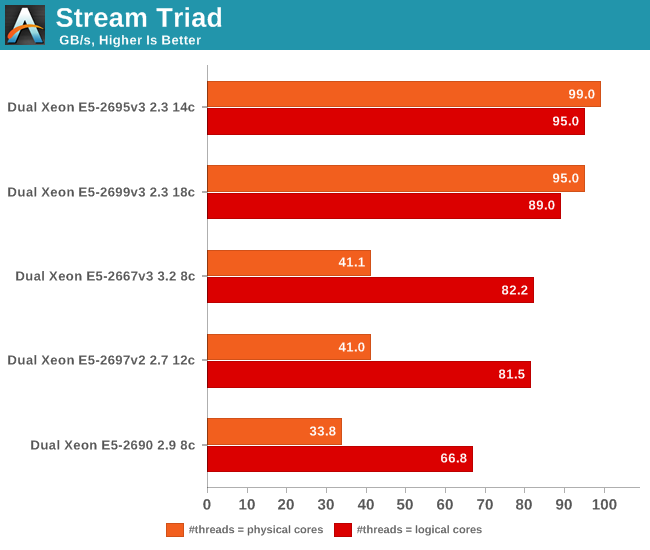Intel Xeon E5 Version 3: Up to 18 Haswell EP Cores
by Johan De Gelas on September 8, 2014 12:30 PM ESTMemory Subsystem Bandwidth
Let's set the stage first and perform some meaningful low level benchmarks. First, we measured the memory bandwidth in Linux. The binary was compiled with the Open64 compiler 5.0 (Opencc). It is a multi-threaded, OpenMP based, 64-bit binary. The following compiler switches were used:
-Ofast -mp -ipa
The results are expressed in GB per second. Note that we also tested with gcc 4.8.1 and compiler options
-O3 –fopenmp –static
Results were consistently 20% to 30% lower with gcc, so we feel our choice of Open64 is appropriate. Everybody can reproduce our results (Open64 is freely available) and since the binary is capable of reaching higher speeds, it is easier to spot speed differences. First we compared our DDR4-2133 LRDIMMs with the Registered DDR4-2133 DIMMs on the Xeon E5-2695 v3 (14 cores at 2.3GHz, Turbo up to 3.6GHz).

Registered DIMMs are slightly faster at 1DPC, but LRDIMMs are clearly faster when you insert more than one DIMM per channel. We measured a 16% to 18% difference in performance. It's interesting to note that LRDIMMs are supposed to run at 1600 at 3DPC according to Intel's documentation, but our bandwidth measurement points to 1866. The command "dmidecode -type 17" that reads out the BIOS confirmed this.
Next, we compared the different Xeon platforms.

The new Xeon E5-2600 v3 has access to 15-21% more bandwidth than the E5-2600 v2, which uses DDR3-1866, and almost 50% more than the first Xeon E5s (DDR3-1600). Interestingly, the previous generation Xeons and the Xeon E5-2667 v3 need to use one thread per logical thread to use the full potential of the memory controller. The reason that the Xeon E5-2667 v3 shows similar behavior as the previous Xeons is that it is also a die with one dual ring and one memory controller. Also, 16 threads (one per physical core) is probably not enough to get the full potential of a quad channel DDR4-2133 memory subsystem. The new High Core Count (HCC, 14-18 core) Xeon E5 chips perform better with one thread per physical processor.
Although it makes sense that a CPU needs a certain number of threads to get its memory controller working at full speed, it's still interesting to note that the previous 12-core Xeon E5-2697 v2 can only offer 41GB/s at 24 threads while the 14-core Xeon E5-2695 v3 is already delivering more than twice as much bandwidth at 28 threads. Of course, those kind of bandwidth numbers only matter for specific HPC benchmarks as the L3 cache (30-45MB L3) will take care of most of the requests. Latency however always matters.










85 Comments
View All Comments
MorinMoss - Friday, August 9, 2019 - link
Hello from 2019.AMD has a LOT of ground to make up but it's a new world and a new race
https://www.anandtech.com/show/14605/the-and-ryzen...
Kevin G - Monday, September 8, 2014 - link
As an owner of a dual Opteron 6376 system, I shudder at how far behind that platform is. Then I look down and see that I have both of my kidneys as I didn't need to sell one for a pair of Xeons so I don't feel so bad. For the price of one E5-2660v3 I was able to pick up two Opteron 6376's.wallysb01 - Monday, September 8, 2014 - link
But the rest of the system cost is about the same. So you get 1/2 the performance for a 10% discount. YEPPY!Kevin G - Monday, September 8, 2014 - link
Nope. Build price after all the upgrades over the course of two years is some where around $3600 USD. The two Opterons accounted for a bit more than a third of that price. Not bad for 32 cores and 128 GB of memory. Even with Haswell-E being twice as fast, I'd have to spend nearly twice as much (CPU's cost twice as much as does DDR4 compared to when I bought my DDR3 memory). To put it into prespective, a single Xeon E5 2999v3 might be faster than my build but I was able to build an entire system for less than the price Intel's flagship server CPU.I will say something odd - component prices have increased since I purchased parts. RAM prices have gone up by 50% and the motherboard I use has seemingly increased in price by $100 due to scarcity. Enthusiast video card prices have also gotten crazy over the past couple of years so a high end video card is $100 more for top of the line in the consumer space.
wallysb01 - Tuesday, September 9, 2014 - link
Going to the E5 2699 isn’t needed. A pair of 2660 v3s is probably going to be nearly 2x as fast the 6376, especially for floating point where your 32 cores are more like 16 cores or for jobs that can’t use very many threads. True a pair of 2660s will be twice as expensive. On a total system it would add about $1.5K. We’ll have to wait for the workstation slanted view, but for an extra $1.5K, you’d probably have a workstation that’s much better at most tasks.Kevin G - Friday, September 12, 2014 - link
Actually if you're aiming to double the performance of a dual Opteron 6376, two E5-2695v3's look to be a good pick for that target according to this review. A pair of those will set you pack $4848 which is more than what my complete system build cost.Processors are only one component. So while a dual Xeon E5-2695v3 system would be twice as fast, total system cost is also approaching double due to memory and motherboard pricing differences.
Kahenraz - Monday, September 8, 2014 - link
I'm running a 6376 server as well and, although I too yearn for improved single-threaded performance, I could actually afford to own this one. As delicious as these Intel processors are, they are not priced for us mere mortals.From a price/performance standpoint, I would still build another Opteron server unless I knew that single-threaded performance was critical.
JDG1980 - Tuesday, September 9, 2014 - link
The E5-2630 v3 is cheaper than the Opteron 6376 and I would be very surprised if it didn't offer better performance.Kahenraz - Tuesday, September 9, 2014 - link
6376s can be had very cheaply on the second-hand market, especially bundled with a motherboard. Additionally, the E5-2630 v3 requires both a premium on the board and DDR4 memory.I'd wager you could still build an Opteron 6376 system for half or less.
Kevin G - Tuesday, September 9, 2014 - link
It'd only be fair to go with the second hand market for the E5-2630v3's but being new means they don't exist. :)Still going by new prices, an Opteron 6376 will be cheaper but roughly 33% from what I can tell. You're correct that the new Xeon's have a premium pricing on motherboards and DDR4 memory.